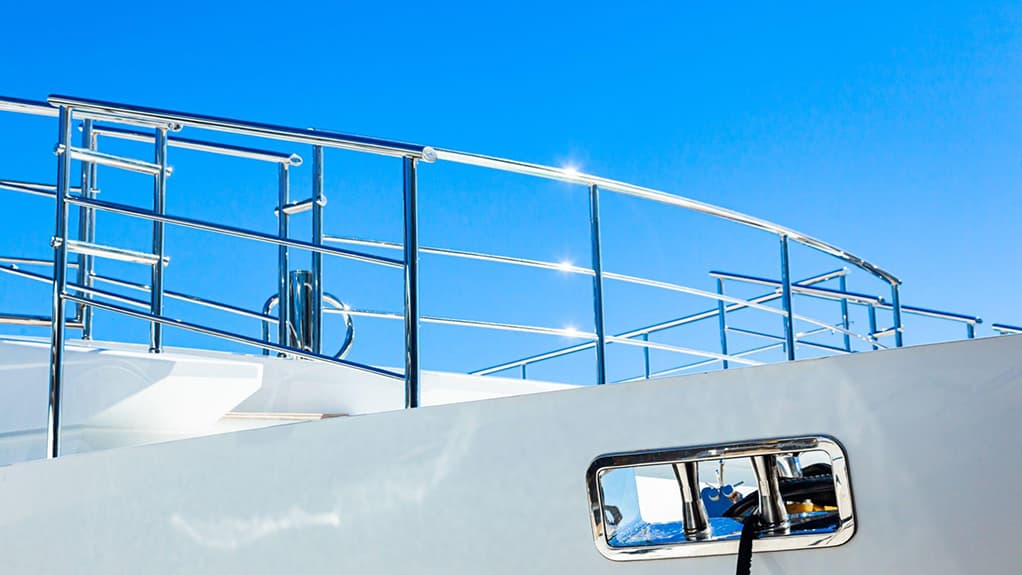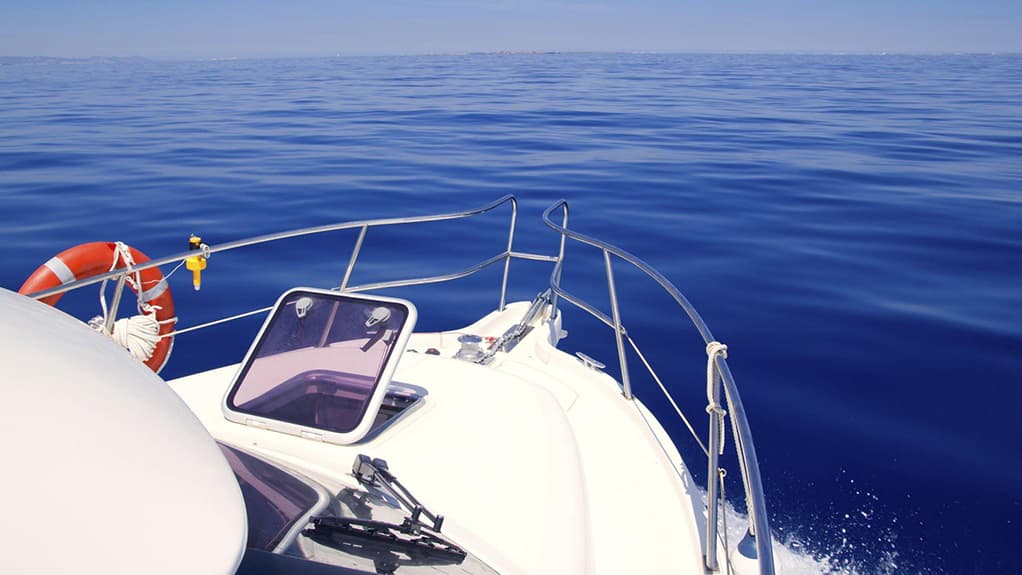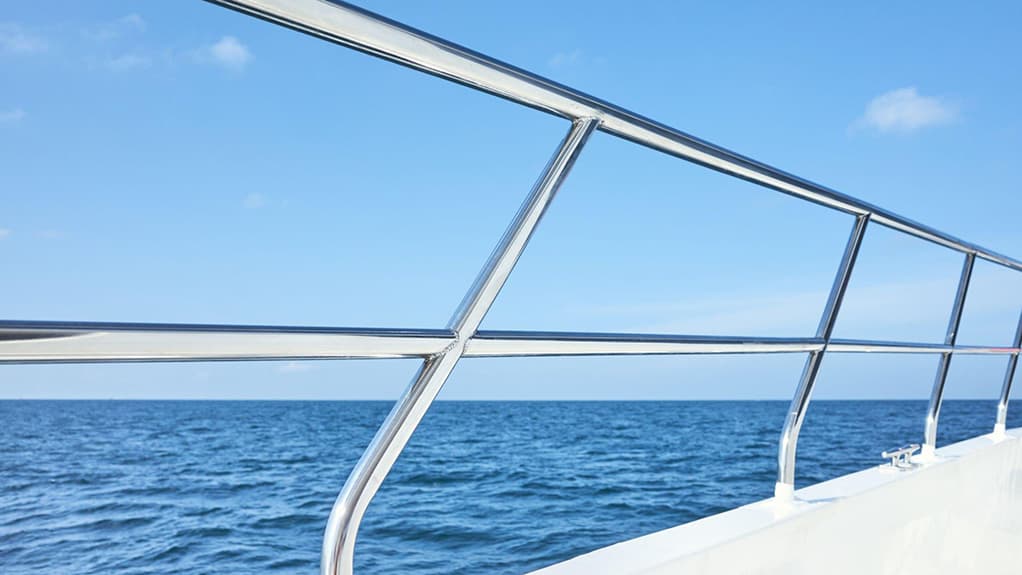Boat rails are essential for marine vessels. They provide safety, comfort, and stability while preventing people from falling overboard, especially in rough waters. In addition to ensuring safe sailing, boat rails help passengers navigate the boat.
Table of Contents
All boat rails, be it stern rail, bow rail, or any other, are equally important. As passengers rely on them for safety, they must be made from durable materials capable of withstanding the dangers of open waters.
Marine-grade stainless steels, such as 316L steel, are the best choice for boat rails with their superior corrosion resistance, ability to withstand extreme weather conditions, and resistance to wear and tear.
Stainless steel, especially marine-grade, not only provides safety but is cost-effective. You save more in the long term by cutting costs on maintenance, replacement, and repair.
While 316L steel is one strong candidate for boat rails, others might be better for your specific needs. In this Unity Metal guide, we’ll cover insightful tips on how to choose stainless steel boat rails – and some tips on how to make everything work. Read to the end to make a well-informed decision.

Material Grade
It’s essential to understand the differences between different grades of stainless steel used for boat rails and their properties. Every steel has its own properties. These reflect on the boat rail’s overall performance. Here are some of the most popular steel choices for boat rails.
304 stainless steel
304 stainless steel, also known as 18/8 steel, is highly corrosion-resistant and affordable. It’s a popular steel with numerous applications, from splashbacks and sinks to sanitaryware.
304 stainless steel is a good choice for boat rails, with many boats featuring rails made from it. However, it isn’t considered marine-grade stainless steel. 304 stainless steel is more susceptible to pitting and crevice corrosion compared to marine-grade stainless steels.
If the affordability of 304 stainless steel attracts you, consider using rails made from it in areas of the boat that are less exposed to corrosive environments. Using 304 stainless steel boat rails for interior railings and others that stand above the waterline can save you money.

316L stainless steel
316L stainless steel has an abundance of nickel and molybdenum in its composition for improved corrosion resistance. It’s one of the most popular marine-grade steels used for boat rails. 316L has excellent strength, durability, and resistance to stress corrosion cracking, making it perfect for marine environments.
The high molybdenum and nickel content enhances the steel’s resistance to pitting and crevice corrosion. It ensures long-lasting performance, even when exposed to saltwater constantly. 316L stainless steel maintains its lustrous appearance over time, providing both functionality and aesthetic appeal.
All these come with a low-maintenance nature that doesn’t require demanding upkeep. Regular cleaning is enough to ensure it delivers consistent performance. 316L steel also has good weldability, which allows rails to be installed without welding complications.
Overall, 316L stainless steel is one of the top choices for various rail applications, from stern rails to stanchions.

Duplex 2205
Duplex 2205 stainless steel is known for its exceptional strength and corrosion resistance. It has high chromium, molybdenum, and nitrogen. All these alloying elements contribute to its resistance against pitting, crevice corrosion, and stress corrosion cracking.
Duplex 2205 is a tad bit better than 316L in corrosion resistance and strength. As you can expect, it makes a perfect boat rail material. It ensures maximum durability and maintains its appearance with minimal maintenance.
Although it’s an outstanding choice for boat rails, Duplex 2205 is expensive. That tiny fraction of higher value Duplex 2205 offers over 316L isn’t something most need. That’s why you might want to consider choosing 316L stainless steel instead of Duplex 2205.

Duplex 2507
Duplex 2507 stainless steel is a super duplex alloy with exceptional strength and corrosion resistance superior to most steels. It arguably makes one of the best products in corrosive environments.
However, Duplex 2507 is very expensive. The high cost of this steel reserves its application to industries where high levels of corrosion resistance and strength are required. Sure, Duplex 2507 makes a better boat rail, but it isn’t easy to justify its cost for most boat rail applications.
For most boat rail applications, though, Duplex 2205 and 316L stainless steel offers more value with their performance and durability at a reasonable cost.
Railing Design
The railing design should complement your vessel’s style regardless of the stainless steel grade. A quick Google search can give you a sense of what would work with your boat.
However, note that not every boat rail will have customization options – or at least to the degree you want. Depending on the weldability of the steel, the customizations might be limited. Better weldability also means easier installation if required in the installation process.
Just a quick note – We ship out easy-to-install products that don’t require welding or specialized gear to install at Unity Metal.
Most importantly, your design must meet the safety requirements for the vessel’s intended use. The regulations around boat rails vary depending on location. Even different cities in the same region might have distinct safety requirements.
It’s critical to research and understand the regulations when selecting a design. By doing so, you will meet safety requirements and further increase the sturdiness of the rail materials while matching aesthetic preferences.

Installation Options
With boat rails, you have two installation options. You can either DIY your way through it or hire a professional to do the installation for you. Each has its advantages and disadvantages.
Let’s assume you choose to do it yourself; here would be the pros and cons.
Pros
- Cost-effective: Since you don’t have to pay anyone to install the rails, you can save hundreds on installation costs.
- Convenient: You can install everything at your own pace without restricting yourself to someone else’s schedule. You can even treat this as a leisurely activity.
- Customizations: With DIY installation, you will have complete control over how you want to install and customize based on your preferences and needs.
Cons
- Possible errors: With DIY installation, there’s always the risk of mistakes that can put the system at risk and result in security vulnerabilities.
- Experience: Since you don’t have the expertise of a professional installer, you may not be aware of mistakes that can lead to poor installation overall.
- Troubleshooting: If you encounter any problems during or after installation, troubleshooting will be more difficult and time-consuming.
You should weigh the pros and cons and decide for yourself. DIY installation is a fun challenge but remember – proper installation is crucial for safety. When installed correctly, it can compromise the integrity of the system.
Maintenance
Stainless steel boat rails must be maintained regularly to ensure longevity. Corrosion resistance is a key factor in the boat rail’s maintenance needs. The better corrosion resistance steel has, the less care it will need. Also, boat rails hold up to dents and other damage better as the steel’s strength increase.
Here are some tips to keep boat rails at their best.
- Clean regularly: Wash your boat rails regularly with soap and water to prevent salt buildup, which can lead to rust and corrosion.
- Apply protective coatings: A protective coating suitable for boat rails protects them from scratches and corrosive marine environments.
- Inspect often: Check for damages regularly. If there are any damages, address them accordingly.
- Address rust and corrosion: Use rust remover immediately if you spot any rusted or corroded parts to prevent further decay.
- Avoid abrasive tools: Whether cleaning or removing scratches, avoid using tools and equipment that can further cause damage.
Upkeeping stainless steel boat rails is similar to caring for any other stainless steel railing system. There aren’t many differences between maintaining a stainless steel baluster and a boat rail, for example.
Conclusion
Choosing the right stainless steel boat rails will increase your vessel’s aesthetic appeal while providing the crucial safety everyone on board needs.
Consider your budget, steel grade, design options, and maintenance needs of each component and how it all comes together with your vessel to make the right choice. With that, your boat rails will last you for years – partaking in your journeys.
At Unity Metal, we manufacture various railing systems with different applications suited for a wide range of people. Regardless of your budget or project size, we can supply you with high-quality railing products.
We also offer our products wholesale. Contact us to request a free quote.


